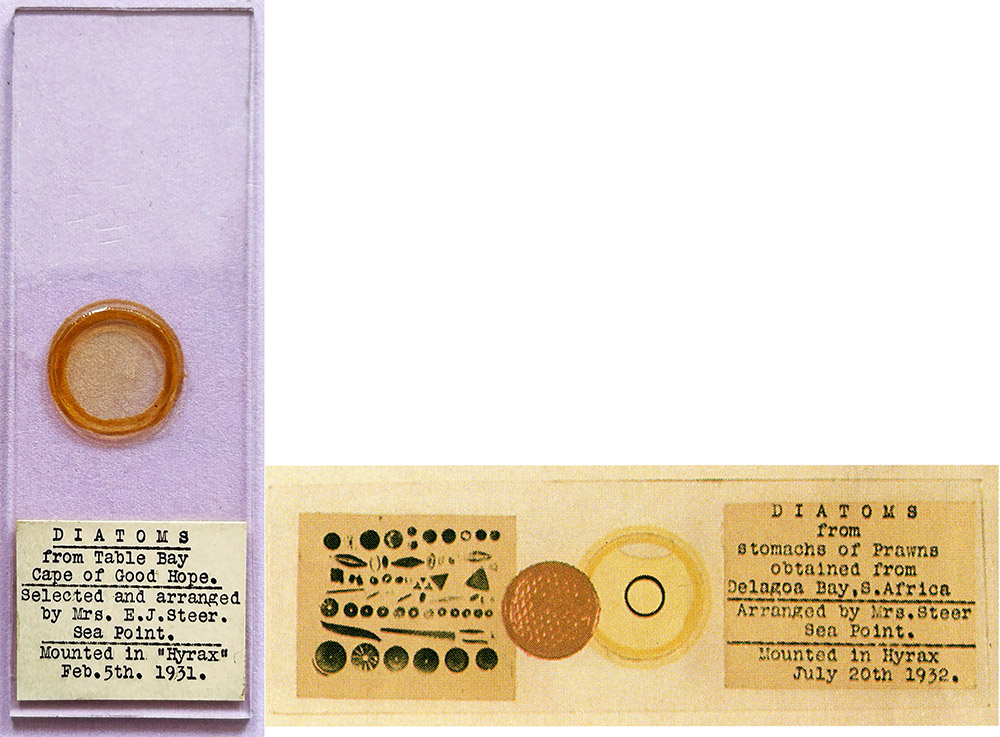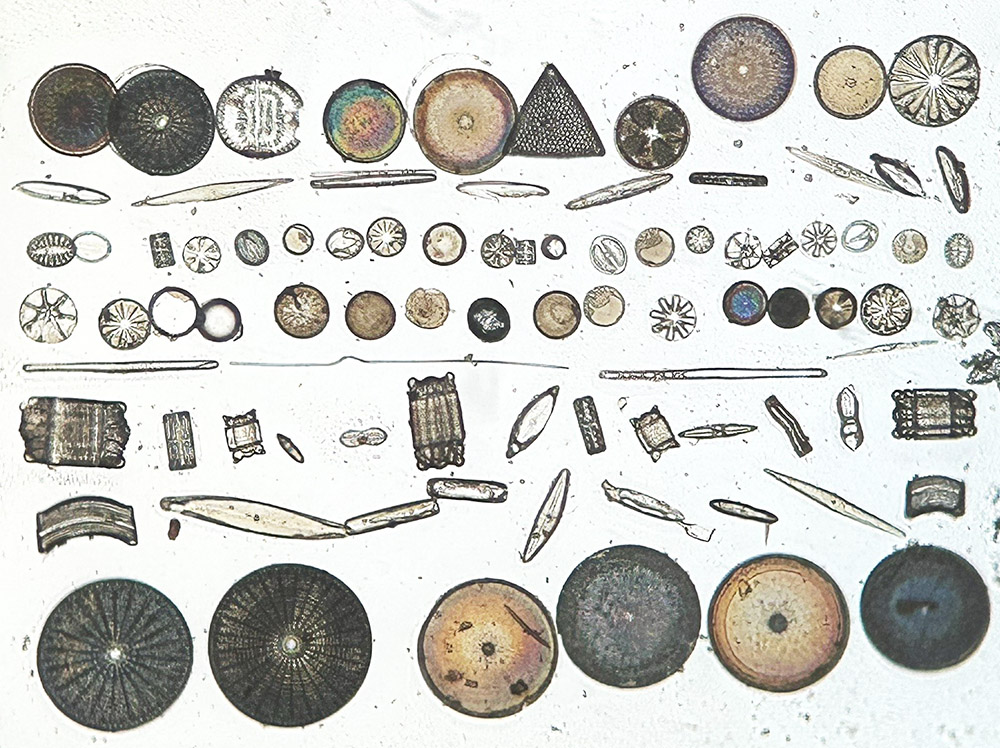
Figure 1. Slides by “Mrs. Steer”. Adapted for nonprofit, educational purposes from Bracegirdle, 1998, and an internet auction site.
Ellen Kate Willis Steer, 1861 - 1955
“Mrs. E.J. Steer”
Edward James Steer, 1863 - 1945
by Brian Stevenson
Last updated April, 2025
As was typical of her times, Ellen Steer was known socially by her husband’s name, “Mrs. E.J. Steer”. In her personal life, she went by “Nell”. She and her husband, Edward, were both members of the same naturalist clubs in South Africa, and probably participated equally. The pair had strong interests in collecting and studying diatoms. It was there that Nell excelled far beyond Edward, described by a colleague as “making most beautiful slides of these microscopic gems”. Slides by “Mrs. Steer” contain arrays of selected and arranged diatoms that were collected from specific sites (Figures 1 and 2).

Figure 1.
Slides by “Mrs. Steer”. Adapted for nonprofit, educational purposes from Bracegirdle, 1998, and an internet auction site.

Figure 2.
Magnified details of a Nell Steer slide of arranged diatoms extracted out of guano from the west coast of South Africa (see Figure 1). Imaged with a 10x objective lens and C-mounted digital SLR camera on a Leitz Ortholux II microscope.
Very little was written about Nell Steer outside of the context of her husband. As noted above, she and Edward were members of the same clubs, and evidently had similar interests in exploring and studying nature. It is thus probable that contemporary descriptions of Edward’s scientific life also apply to Nell.
Ellen Kate Willis was born on July 22, 1861 in Cheltenham, Gloucestershire, UK. She was the second child, and only daughter, of Hubert Deyton and Sarah Elizabeth Willis. Father Hubert worked as a railway station master at the time of the 1871 national census, and as a coal merchant during the 1881 census. The family enjoyed the comfort of a live-in servant in 1881.
Edward James Steer was born in early 1863 in Maidstone, Kent. He was the eldest child of James Hadden and Rebecca Day Steer. The father was a cabinet maker, and evidently a successful one, as the family employed a domestic servant.
Edward took work as a clerk with the Gresham Life Assurance Company, then located in the London area. He moved to Cape Town, South Africa in 1891, as Assistant Secretary of the Southern Life Association. Presumably, Edward and Nell married in England before that move, noting that Nell Willis’ parents continued to live in England. I have not found records of their marriage, nor of either person in the 1891 UK national census.
Soon after arriving in South Africa, Edward, and presumably also Nell, became involved with local photography, nature, and outdoor activities. They both joined the Mountain Club of South Africa, the Botanical Society of South Africa, and the Cape Natural History Club. In 1893, Edward voluntarily exhibited a collection of English prize-winning photographs around Cape Colony, and produced a series of South African photographs for display in England. In 1909, he published a letter in Nature that described a phenomenal meteor in his sky.
An obituary of Edward stated that “he used to roam the Peninsula mountains with a camera, in company with his wife and two sons”. Both boys were killed during World War I, James in Palestine in 1917 and Edward in Egypt in 1918.
Edward’s boss at the Southern Life Association retired in 1925, and Edward took over the position of company Secretary. He retired in 1928, “after thirty-seven years’ service”.
Edward provided photographs for several publications over the years, including A Book of South African Flowers and A Second Book of South African Flowers.
Edward and Nell were acknowledged in a 1925 article on South African charophyte algae “Our thanks are due to … Mr. and Mrs. E.J. Steer of Sea Point, Cape Town … for much assistance … in the work of collecting”.
Edward (and possibly Nell) was a member of the South African Microscopical Society. He served as Secretary in 1936.
Noting the expected roles of husbands and wives of the time, Edward was the primary outward face of the Steer couple, while Nell was generally shown in a supporting role. She was, however, recognized as the expert in mounting diatoms for the microscope.
For example, a 1931 letter by Nicholas Brown on “An interesting diatom” began, “Last year I received from Mr. E.J. Steer, of Sea Point, South Africa, a slide of Glyphodiscus, nicely mounted by Mrs. Steer, which he had found living and growing on seaweed on rocks at Gordons Bay”.
Also in 1931, Edward wrote an article on glass tanks for use with microscopes for Watson’s Microscope Record. He noted, “In places so far from the ‘Home of Microscopy’ (needless to say this is a synonym for Watson’s) as this is, one is obliged to make a lot of simple gadgets at home, as local dealers do not carry a large stock of micro. sundries; and the above is written in the hope that others similarly situated may find it helpful”.
Nicholas Brown, in his 1933 book on Arachnoidiscus, acknowledged “the recent discovery made by Mr. and Mrs. E.J. Steer of Cape Town, South Africa, of the conjoining frustules and sporange cases of A. ornatus, of which they have very kindly sent me samples and allowed me to make use of them ... Mr. and Mrs. Steer have found upon seaweed (Suhria vittata) which they collected about the year 1928 on the shore of Witzands Bay , a number of frustules of A. ornatus with multiple girdles”.
“Mr. E.J. Steer, of 61, Kloof Road, Sea Point, Cape Town” offered to sell tubes “containing about 3,000 assorted marine diatoms, cleaned ready for mounting” in 1935 (Figure 3). The Steers published offers in the English magazine The Microscope in 1938, seeking to exchange South African “material” for English “pond-life”. “Steer, E.J.” was listed in editions of The Naturalists’ Directory, noting that they were interested in exchanging diatoms.
A memoriam of Edward wrote that “he devoted most of his time to Microscopy. He took up the study of that very important group, the Diatoms, and specialised in the study of the South African marine forms. Mrs. Steer helped him by making most beautiful slides of these microscopic gems, from material collected by himself or through friends, right round the coasts of Southern Africa. By exchanging slides and material with diatomists all over the world, he accumulated the valuable "Steer Diatom Collection”, now the property of the Bolus Herbarium, University of Cape Town. Though Diatoms became his main interest, Mr. Steer was interested in all branches of Natural History, and was one of the founders (1922) of the Cape Natural History Club. To the service of this club, and of anyone wishing help in the study of Natural History, he gave most generously of his time and of his skill in photography and microscopy. Generosity and helpfulness indeed were his outstanding characteristics, another delightful one being a vivid sense of humour. The death of this lovable naturalist at the age of eighty-two is a is a loss not only to his many friends here and diatom friends-by-correspondence overseas, but to natural history in South Africa”.
Edward died of lung cancer on May 17, 1944.
Nell Steer died at the age of 94 on December 21, 1955, from “intra peritoneal abscess of unknown origin. (She) had a fractured femur operation 4 months (previously)”.

Figure 3.
Examples of advertisements from the Steers, through which they built their collection of diatoms and other material. From “The Education Gazette” and “The Microscope”.
Resources
Barclay, Dorothy, Harriet M.L. Bolus, and Edward J. Steer (1925) A Book of South African Flowers, Specialty Press of South Africa Limited, Cape Town
Bolus, Harriet M.L., Dorothy Barclay, and Edward J. Steer (1936) A Second Book of South African Flowers, Specialty Press of South Africa Limited, Cape Town
Bracegirdle, Brian (1998) Microscopical Mounts and Mounters, Quekett Microscopical Club, London, pages 88 and 168, Plate 32-P
Brown, N.E. (1931) An interesting diatom, hydrax versus styrax, English Mechanics, page 636
Brown, N.E. (1933) Arachnoidiscus. An account of the genus, comprising its history, distribution, development and growth of the frustule, structure and its examination and purpose in life, and a key to and descriptions of all known species, illustrated, Watson and Sons, London, page 26
Bulpin, Thomas V. (1966) The Southern: 75 Years of Service, Southern Life Association, pages 6 and 38
Cairo War Memorial (accessed April, 2025) “Steer, Gnr. Edward, 1988. South African Field Artillery. 3rd Nov., 1918. Age 19. Son of Edward James and Ellen Kate Steer, of Capetown. His elder brother, Lt. James H. Steer, was killed in action Dec., 1917, in Palestine”, accessed through ancestry.com
Death record of Edward James Steer (1944) accessed through familysearch.org
Death record of Ellen Kate Steer (1955) accessed through familysearch.org
The Education Gazette (1935) Note on availability of diatoms from E.J. Steer, Vol. 34, page 742
England census and other records, accessed through ancestry.com
Farmer's Weekly (1928) “Mr. E.J. Steer, Secretary of the Southern Life Association of Africa, has retired on pension, after thirty-seven years’ service”, page 1652
Groves, James, and Edith L. Stephens (1925) New and noteworthy South African Charophyta, Transactions of the Royal Society of South Africa 1925 – 1926, Vol. 13, pages 147-158
Journal of the Botanical Society of South Africa (1922) Members
Journal of the Botanical Society of South Africa (1930) Members
Journal of the Mountain Club of South Africa (1945) Mr. E.J. Steer, page 51
The Microscope (1938) Exchange offer from “Steer”, pages 105, 168, 252
Mountain Club of South Africa Annual (1915) Members
The Naturalist's Directory (1940) “Steer , E.J., 61 Kloof Rd., Sea Point, Cape Town, Africa. Diatoms. Ex”, page 239
Photography (1893) “Mr. Edward J. Steer of Cape Town …”, Vol. 5, page 5
The Review (1925) Southern Light, January, 1925, Vol. 56, page 297
The Review (1928) Southern Life Association (of South Africa), Vol. 59, page 38
Steer, Edward J. (1909) Persistent trail of a meteor on March 14, Nature, page 248
Steer, Edward J. (1931) Glass tanks for the microscope, Watson's Microscope Record, page 23
Watson's Microscope Record (1936) South African Microscopical Society